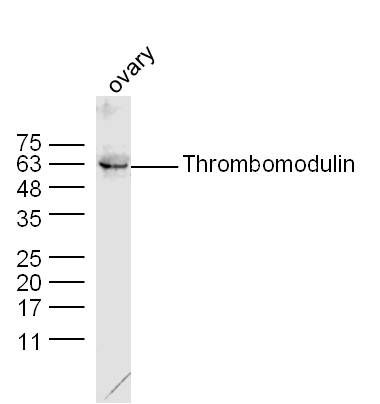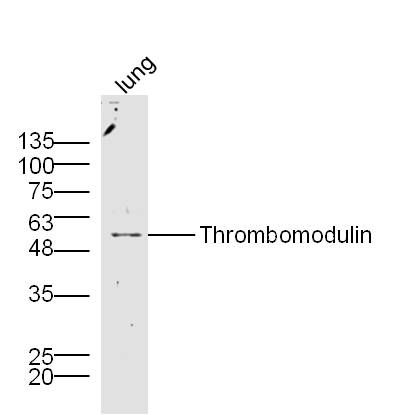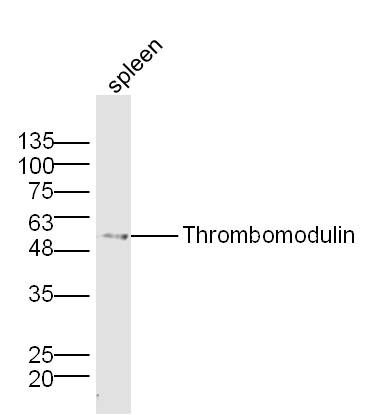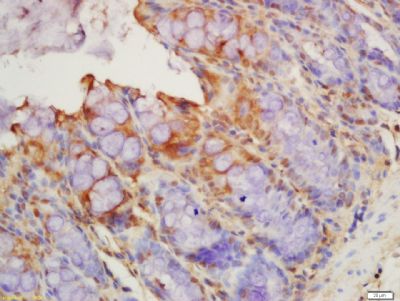产品中心
当前位置:首页>产品中心Anti-Thrombomodulin
货号: bs-10212R 基本售价: 1380.0 元 规格: 100ul
- 规格:100ul
- 价格:1380.00元
- 规格:200ul
- 价格:2200.00元
产品信息
- 产品编号
- bs-10212R
- 英文名称
- Thrombomodulin
- 中文名称
- 血栓调节蛋白抗体
- 别 名
- Thrombomodulin; CD 141; CD141; CD141 antigen; Fetomodulin; THBD; THRM; TM; AHUS 6; AHUS6; BDCA 3; BDCA3; THPH12; TRBM_HUMAN.
- 规格价格
- 100ul/1380元购买 200ul/2200元购买 大包装/询价
- 说 明 书
- 100ul 200ul
- 研究领域
- 抗体来源
- Rabbit
- 克隆类型
- Polyclonal
- 交叉反应
- Human, Mouse, Rat, Dog, Cow,
- 产品应用
- WB=1:500-2000 ELISA=1:500-1000 IHC-P=1:400-800 IHC-F=1:400-800 ICC=1:100-500 IF=1:100-500 (石蜡切片需做抗原修复)
not yet tested in other applications.
optimal dilutions/concentrations should be determined by the end user.
- 分 子 量
- 61kDa
- 细胞定位
- 细胞膜 细胞外基质
- 性 状
- Lyophilized or Liquid
- 浓 度
- 1mg/ml
- 免 疫 原
- KLH conjugated synthetic peptide derived from mouse Thrombomodulin/CD141:301-400/575 <Extracellular>
- 亚 型
- IgG
- 纯化方法
- affinity purified by Protein A
- 储 存 液
- 0.01M TBS(pH7.4) with 1% BSA, 0.03% Proclin300 and 50% Glycerol.
- 保存条件
- Store at -20 °C for one year. Avoid repeated freeze/thaw cycles. The lyophilized antibody is stable at room temperature for at least one month and for greater than a year when kept at -20°C. When reconstituted in sterile pH 7.4 0.01M PBS or diluent of antibody the antibody is stable for at least two weeks at 2-4 °C.
- PubMed
- PubMed
- 产品介绍
- background:
Thrombomodulin, TM is cell surface glycoprotein; plays an important role in the protein C anticoagulant pathway. It located in a vein, artery and capillary endothelial cells on the surface of plasma membrane protein. It is generally believed: TM vascular endothelial injury is an important parameter is the thrombin receptor, known in a variety of normal human tissues, can also be expressed in many tumors, TM may be similar to the E-cadherin,and is a lectin Like activity of a new class of members of the cell adhesion molecules.
CD141/Thrombomodulin is an exclusively endothelial cell surface glycoprotein that forms a 1:1 complex with thrombin. Binding of thrombin to this high-affinity receptor alters its specificity toward several substrates. The complex activates protein C approximately 1000 times faster than thrombin alone. Activated protein C degrades clotting factors V and VIII; thus, thrombomodulin converts thrombin into a physiologic anticoagulant. Thrombomodulin is also found in the circulatory and urinary systems, the physiologic significance of this is obscure.
Function:
Thrombomodulin is a specific endothelial cell receptor that forms a 1:1 stoichiometric complex with thrombin. This complex is responsible for the conversion of protein C to the activated protein C (protein Ca). Once evolved, protein Ca scissions the activated cofactors of the coagulation mechanism, factor Va and factor VIIIa, and thereby reduces the amount of thrombin generated.
Subcellular Location:
Membrane; Single-pass type I membrane protein.
Tissue Specificity:
Endothelial cells are unique in synthesizing thrombomodulin.
Post-translational modifications:
N-glycosylated.
The iron and 2-oxoglutarate dependent 3-hydroxylation of aspartate and asparagine is (R) stereospecific within EGF domains.
DISEASE:
Defects in THBD are the cause of thrombophilia due to thrombomodulin defect (THPH12) [MIM:614486]. A hemostatic disorder characterized by a tendency to thrombosis.
Defects in THBD are a cause of susceptibility to hemolytic uremic syndrome atypical type 6 (AHUS6) [MIM:612926]. An atypical form of hemolytic uremic syndrome. It is a complex genetic disease characterized by microangiopathic hemolytic anemia, thrombocytopenia, renal failure and absence of episodes of enterocolitis and diarrhea. In contrast to typical hemolytic uremic syndrome, atypical forms have a poorer prognosis, with higher death rates and frequent progression to end-stage renal disease. Note=Susceptibility to the development of atypical hemolytic uremic syndrome can be conferred by mutations in various components of or regulatory factors in the complement cascade system. Other genes may play a role in modifying the phenotype.
Similarity:
Contains 1 C-type lectin domain.
Contains 6 EGF-like domains.
SWISS:
P07204
Gene ID:
7056
Database links:Entrez Gene: 7056Human
Omim: 188040Human
SwissProt: P07204Human
Unigene: 2030Human
Important Note:
This product as supplied is intended for research use only, not for use in human, therapeutic or diagnostic applications.
- 产品图片
 Sample: ovary (Mouse) Lysate at 40 ug
Sample: ovary (Mouse) Lysate at 40 ug
Primary: Anti-Thrombomodulin(bs-10212R) at 1/300 dilution
Secondary: IRDye800CW Goat Anti-Rabbit IgG at 1/20000 dilution
Predicted band size: 61 kD
Observed band size: 61 kD Sample:
Sample:
Lung (Mouse) Lysate at 40 ug
Primary: Anti- Thrombomodulin (Bs- 10212R) at 1/300 dilution
Secondary: IRDye800CW Goat Anti-Rabbit IgG at 1/20000 dilution
Predicted band size: 61 kD
Observed band size: 61 kD Sample: spleen (Mouse) Lysate at 40 ug
Sample: spleen (Mouse) Lysate at 40 ug
Primary: Anti-Thrombomodulin(bs-10212R) at 1/300 dilution
Secondary: IRDye800CW Goat Anti-Rabbit IgG at 1/20000 dilution
Predicted band size: 61 kD
Observed band size: 58 kD Tissue/cell: rat colon tissue; 4% Paraformaldehyde-fixed and paraffin-embedded;
Tissue/cell: rat colon tissue; 4% Paraformaldehyde-fixed and paraffin-embedded;
Antigen retrieval: citrate buffer ( 0.01M, pH 6.0 ), Boiling bathing for 15min; Block endogenous peroxidase by 3% Hydrogen peroxide for 30min; Blocking buffer (normal goat serum,C-0005) at 37℃ for 20 min;
Incubation: Anti-Thrombomodulin Polyclonal Antibody, Unconjugated(bs-10212R) 1:200, overnight at 4°C, followed by conjugation to the secondary antibody(SP-0023) and DAB(C-0010) staining

